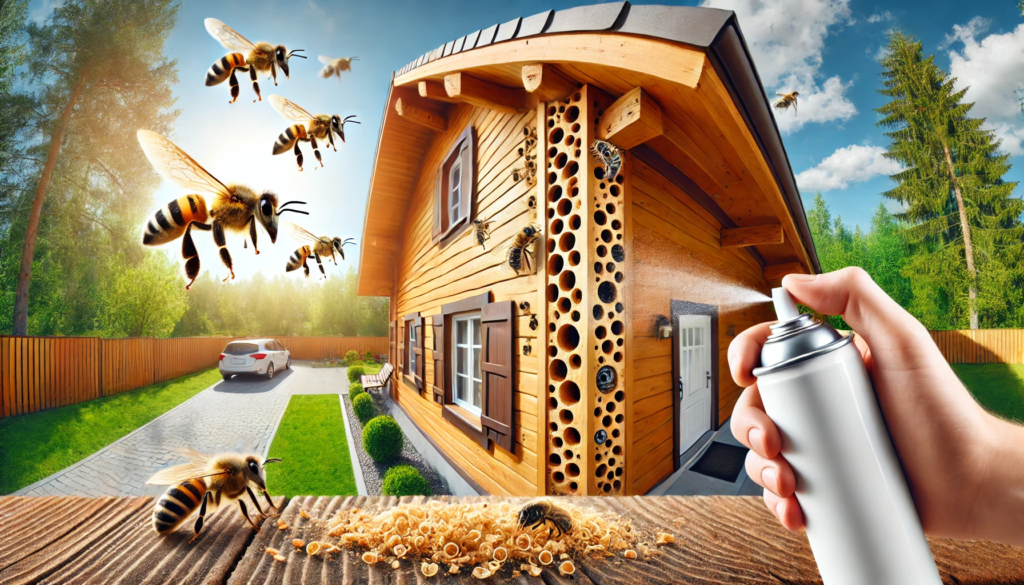Carpenter bees can cause significant damage to wooden structures around your home. If you’ve noticed them hovering near wooden surfaces, it’s time to take action.
Today, I’ll share effective ways to get rid of carpenter bees and prevent future infestations.
What Are Carpenter Bees?
Carpenter bees (Xylocopa) are large, solitary bees that burrow into wood to create nests. Unlike termites, they don’t eat the wood but still cause structural damage over time.
They are often mistaken for bumblebees but can be identified by their shiny, black abdomens.
Signs of Carpenter Bee Infestation
Before tackling the problem, it’s essential to confirm an infestation. Here are some signs:
- Small, perfectly round holes in wooden structures
- Sawdust-like shavings beneath these holes
- Yellowish stains near entry points
- Increased bee activity around wood surfaces
- A buzzing sound coming from wooden areas
If you are interested in General Knowledge and Fun Questions, read our recent blogs:
How Old is Eminem
How Old is Queen Cheryl
How Old is Jim Parsons

How to Get Rid of Carpenter Bees
1. Use Natural Repellents
Certain natural substances can deter carpenter bees effectively:
- Citrus Oil:
Bees dislike the scent of citrus. Spray a citrus oil solution into their holes. - Almond Oil:
Applying almond oil around affected areas prevents future nesting. - Vinegar Spray:
Mix equal parts vinegar and water, then spray directly into the nest.
2. Seal the Holes
Once the bees have left the nest, seal their entry points using:
- Wood filler
- Steel wool and caulk
- Paint or varnish to deter future burrowing
3. Use Carpenter Bee Traps
Traps are an effective way to capture and remove carpenter bees. You can buy pre-made traps or build your own using a wooden box with drilled holes leading to a plastic container.
4. Apply Residual Insecticides
For severe infestations, insecticides with pyrethroids can help eliminate carpenter bees. Apply the insecticide directly into the tunnels, following safety guidelines.
5. Install Hardwood or Painted Surfaces
Carpenter bees prefer untreated wood. To discourage nesting, apply:
- A coat of paint or varnish
- Vinyl or aluminum sidings in vulnerable areas
- Hardwood materials instead of softwood
6. Introduce Natural Predators
Encouraging natural predators like woodpeckers and wasps can help reduce carpenter bee populations. However, be mindful that some of these predators can cause other problems.
7. Use Noise to Drive Them Away
Carpenter bees are sensitive to vibrations. Placing a loud speaker near their nest can encourage them to leave.
How to Clear Instagram Cache on iPhone
Preventing Future Infestations
Once you’ve removed the carpenter bees, take preventive measures to ensure they don’t return:
- Keep wood surfaces painted and sealed.
- Replace rotting wood with treated materials.
- Regularly inspect wooden structures for early signs of activity.
- Use carpenter bee deterrents such as diatomaceous earth in vulnerable areas.
Are Carpenter Bees Dangerous?
While male carpenter bees are aggressive, they cannot sting. Female carpenter bees can sting but only if provoked. The primary concern is the structural damage they cause to wooden areas.
When to Call a Professional
If your infestation is severe, professional pest control services can provide long-term solutions. They use specialized treatments that effectively eliminate carpenter bees and prevent their return.
Final Thoughts
Getting rid of carpenter bees requires a combination of natural and chemical methods, along with preventive measures. By taking early action, you can protect your home from damage and avoid recurring infestations.
